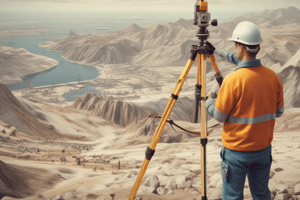Podcast
Questions and Answers
What is the primary purpose of surveying?
What is the primary purpose of surveying?
- To determine the relative positions of features on the Earth's surface (correct)
- To analyze climate change
- To measure the height of mountains
- To create art based on geographical features
The principle of surveying states that it is sufficient to locate a new point with only one measurement from a fixed reference point.
The principle of surveying states that it is sufficient to locate a new point with only one measurement from a fixed reference point.
False (B)
What are the two basic principles of surveying?
What are the two basic principles of surveying?
Work from whole to the part and locate a new station by at least two measurements.
In surveying, points are fixed or located by at least two measurements which can be either ______ or ______.
In surveying, points are fixed or located by at least two measurements which can be either ______ or ______.
Match the surveying principle with its description:
Match the surveying principle with its description:
What is the primary method used to minimize error accumulation in surveying?
What is the primary method used to minimize error accumulation in surveying?
Why is it important to create main control stations in the surveying process?
Why is it important to create main control stations in the surveying process?
How can a new station be accurately fixed or located in surveying?
How can a new station be accurately fixed or located in surveying?
What happens if surveying measurements start from the part instead of the whole?
What happens if surveying measurements start from the part instead of the whole?
Explain the significance of linear and angular measurements in locating new points.
Explain the significance of linear and angular measurements in locating new points.
What is the ultimate goal of determining relative positions in surveying?
What is the ultimate goal of determining relative positions in surveying?
Describe how points A and B can be used to establish a new point C.
Describe how points A and B can be used to establish a new point C.
What is a potential consequence of not controlling measurement errors in surveying?
What is a potential consequence of not controlling measurement errors in surveying?
In what scenarios would one prefer to use angular measurement over linear measurement in surveying?
In what scenarios would one prefer to use angular measurement over linear measurement in surveying?
What is the role of a control station in the surveying process?
What is the role of a control station in the surveying process?
Study Notes
Definition of Surveying
- Surveying is the art of determining the relative positions of features on, above, or below the Earth's surface.
- Utilizes direct or indirect measurements of distance, direction, and elevation.
- Results are represented as plans, maps, or sections.
Objectives of Surveying
- Objectives were mentioned but not detailed in the given information.
Principles of Surveying
- Two fundamental principles guide surveying practices:
- Work from whole to part.
- Fix or locate a new station with at least two measurements from fixed reference points.
Working from Whole to Part
- Survey areas are initiated by enclosing them with main control stations and survey lines to stabilize results.
- This method helps control the accumulation of errors; minor errors have a reduced impact on the overall work.
- Errors become magnified if measurements start from smaller parts instead of the whole.
Locating New Points
- New points can be established based on reference control points through linear or angular measurement.
- For points A and B as reference:
- Distance between A and B is measured accurately to help plot point C.
- Location methods for C may include:
- Linear measurement from control points A and B.
- Perpendicular linear measurement from another reference point D to C.
- One linear measurement from point B combined with one angular measurement.
Definition of Surveying
- Surveying is the art of determining the relative positions of features on, above, or below the Earth's surface.
- Utilizes direct or indirect measurements of distance, direction, and elevation.
- Results are represented as plans, maps, or sections.
Objectives of Surveying
- Objectives were mentioned but not detailed in the given information.
Principles of Surveying
- Two fundamental principles guide surveying practices:
- Work from whole to part.
- Fix or locate a new station with at least two measurements from fixed reference points.
Working from Whole to Part
- Survey areas are initiated by enclosing them with main control stations and survey lines to stabilize results.
- This method helps control the accumulation of errors; minor errors have a reduced impact on the overall work.
- Errors become magnified if measurements start from smaller parts instead of the whole.
Locating New Points
- New points can be established based on reference control points through linear or angular measurement.
- For points A and B as reference:
- Distance between A and B is measured accurately to help plot point C.
- Location methods for C may include:
- Linear measurement from control points A and B.
- Perpendicular linear measurement from another reference point D to C.
- One linear measurement from point B combined with one angular measurement.
Studying That Suits You
Use AI to generate personalized quizzes and flashcards to suit your learning preferences.
Description
This quiz covers the fundamental definitions and objectives of surveying, a crucial aspect of civil engineering. It explores the techniques used to measure distances, directions, and elevations, as well as the representation of these measurements in various formats. Aimed at students in civil engineering, this quiz will reinforce essential knowledge in surveying practices.




